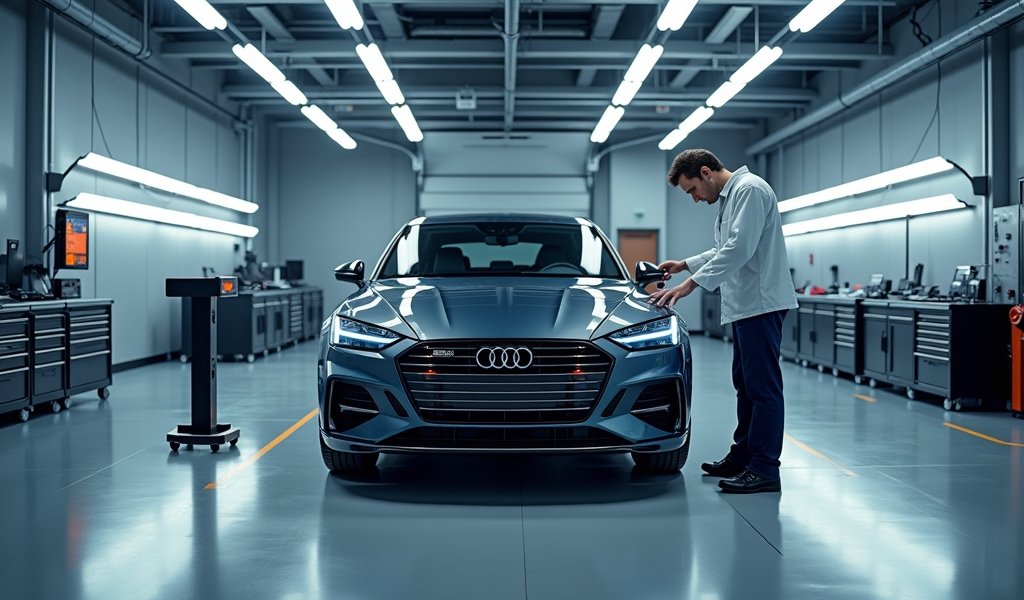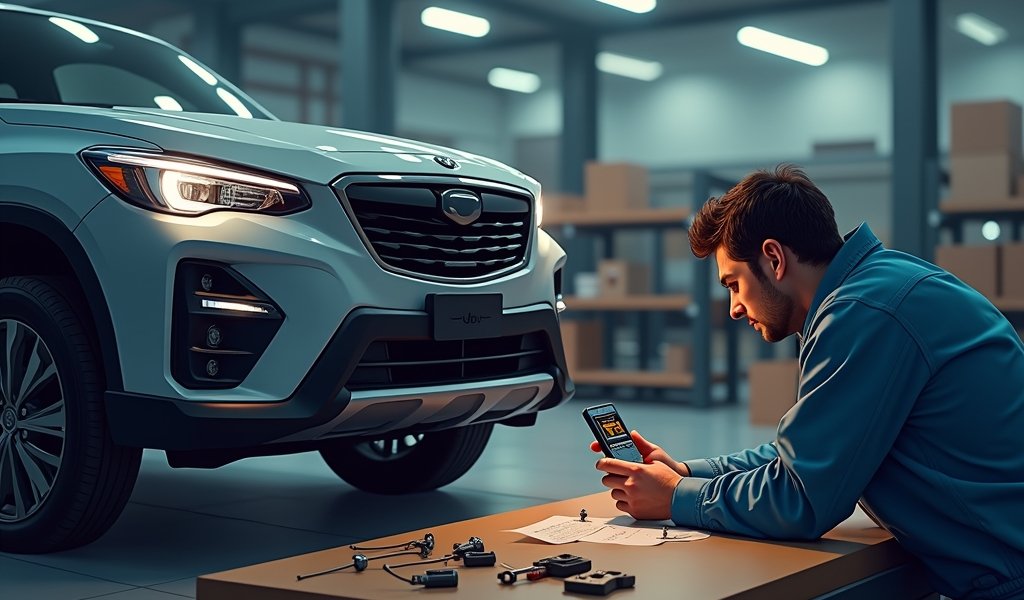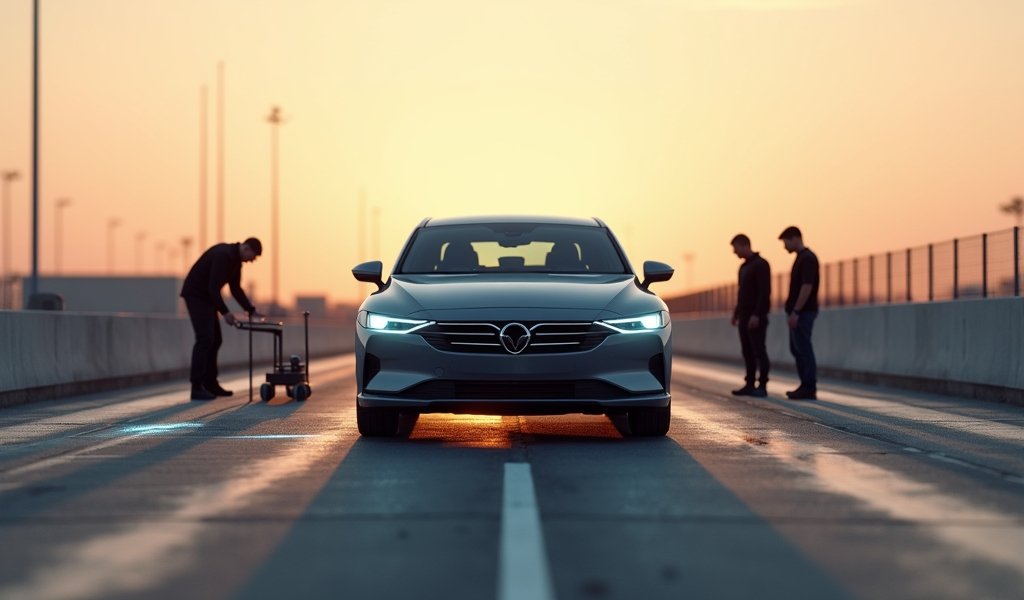Overview
This guide explains how adaptive cruise control (ACC) systems work and why proper calibration is essential for safety and performance. It covers signs that indicate calibration is needed, offers both DIY and professional calibration approaches, provides maintenance tips, and warns about common mistakes to avoid when maintaining this advanced driver assistance technology.
Table of Contents
- Understanding Adaptive Cruise Control
- Why Calibration Matters
- Signs Your ACC Needs Calibration
- DIY Calibration Steps
- Professional Calibration
- Maintenance Tips to Keep Your ACC Working Properly
- Common Calibration Mistakes to Avoid
- Conclusion
- Frequently Asked Questions
Understanding Adaptive Cruise Control
Ah, adaptive cruise control (ACC) – that magical feature that lets you pretend your car is driving itself (well, kind of). If you’re new to this automotive wizardry, adaptive cruise control calibration is essentially making sure your car’s fancy distance-sensing system works correctly. Think of it as teaching your car to judge distances the way you would – except your car doesn’t get distracted by text messages or tasty-looking billboards.
Unlike traditional cruise control that just maintains a set speed, adaptive cruise control uses sensors (usually radar or cameras) to detect vehicles ahead and automatically adjusts your speed to maintain a safe following distance. It’s like having a cautious friend constantly watching the road for you – except this friend lives in your dashboard and never asks to change the radio station.
These systems have become increasingly common in newer vehicles, from luxury models to many everyday cars. They’re part of the growing family of advanced driver assistance systems (ADAS) that make driving safer and, let’s be honest, a little bit lazier – in the best possible way. A properly calibrated ACC system can reduce driver fatigue on long trips and potentially help avoid accidents. That’s right – technology that’s both convenient AND potentially life-saving. What’s not to love?
Why Calibration Matters
You might be wondering, “Why can’t I just let my adaptive cruise control do its thing without all this calibration business?” Well, friend, imagine wearing glasses with the wrong prescription – you’d be squinting, getting headaches, and possibly mistaking fire hydrants for small children. Your ACC without proper calibration is just as confused and potentially problematic.
A properly calibrated adaptive cruise control system ensures your car maintains the correct following distance, applies brakes with appropriate force, and accelerates smoothly when the way is clear. When it’s out of whack, your ACC might brake too harshly (hello, spilled coffee!), follow too closely (goodbye, clean driving record!), or fail to detect vehicles altogether (yikes!).
Calibration becomes especially important after certain events in your car’s life. Had a windshield replacement recently? That camera mount might have shifted ever so slightly. Fender bender? Those radar sensors could be pointing in weird directions. Even something as seemingly innocent as a suspension adjustment can throw off your ACC’s understanding of the road ahead.
Beyond safety, proper calibration can save you money in the long run. A system that’s working correctly won’t cause unnecessary wear on your brakes or burn extra fuel through erratic speed changes. Plus, it’ll help you avoid those costly repairs that come after preventable fender benders. Think of calibration as preventive medicine for your car’s brain – a little attention now prevents bigger headaches later.

Signs Your ACC Needs Calibration
Your car might not be able to speak English, but it definitely communicates when something’s wrong with its adaptive cruise control system. Think of these warning signs as your vehicle’s way of waving a little red flag saying, “Hey, I could use some help here!”
The most obvious sign is when your ACC simply stops working altogether. You might see warning lights on your dashboard – typically a cruise control icon with a line through it or an “ACC Error” message that looks about as welcome as a check engine light at inspection time. If your once-reliable system suddenly doesn’t want to engage, it’s practically screaming for calibration.
Another telltale sign is erratic behavior. Is your car braking unexpectedly when there’s nothing ahead? Or maybe it’s maintaining a following distance that would make even the most aggressive taxi driver nervous? Perhaps it’s the opposite – your car seems oblivious to vehicles ahead until you’re close enough to count the bumper stickers. These inconsistent behaviors usually point to sensors that need recalibration.
You might also notice that your ACC works fine in certain conditions but fails in others. For example, if it only acts up when driving into direct sunlight, the camera-based systems might need adjustment. Similarly, if it works poorly in rain or fog, the radar calibration might be off. Your car’s diagnostic system might even store trouble codes without triggering a warning light – something a scan tool can uncover.
Here’s a quick checklist of signs to watch for:
- Warning lights or error messages related to cruise control
- Inconsistent following distances
- Inappropriate braking (too hard or too soft)
- Failure to detect vehicles ahead
- System works in some conditions but not others
- Strange noises when ACC is engaged (your car shouldn’t sound like it’s thinking too hard)
If you spot any of these symptoms, it’s time to consider calibration before your high-tech helper becomes a high-stress hazard.
DIY Calibration Steps
Before we dive in, a word of caution: DIY calibration isn’t for every vehicle or every driver. Some systems require specialized equipment that costs more than a small island nation. But for many vehicles, you can perform basic calibration steps that might save you a trip to the dealership (and keep some dollars in your pocket for more important things – like coffee to fuel your DIY adventures).
First, grab your vehicle’s owner manual. I know, I know – it’s probably stuffed in that glove compartment under fast food napkins and forgotten gas receipts. But trust me, manufacturers often include calibration procedures specific to your vehicle. It’s like having the cheat codes to a video game, except this game involves a two-ton vehicle.
For many vehicles, the calibration process begins with ensuring optimal conditions. Find a straight, flat road with clear lane markings on a day with good visibility. Your car’s sensors need to see clearly – just like you wouldn’t try on new glasses in a dark room. Make sure your windshield is clean and free of cracks, especially in front of any cameras.
Here’s a simplified step-by-step approach that works for many vehicles:
- Start with a system reset. For some vehicles, this means disconnecting the battery for 15-20 minutes (after saving your radio presets, unless you enjoy the adventure of finding new stations). For others, there’s a specific button combination or menu option in your infotainment system.
- Once reset, drive at a steady speed (usually 45-55 mph) on a clear highway with good lane markings for about 15-20 minutes. This allows the system to relearn basic parameters.
- Test various following distances using your ACC controls. Start with the longest setting and gradually decrease, ensuring the system responds appropriately at each step.
- If your vehicle has a specific calibration mode (check that manual!), follow the prompts exactly. These often involve driving patterns like straight lines followed by gentle curves.
Some newer vehicles have self-calibration systems that run diagnostics and adjustments automatically. In these cases, your job is simply to follow the specific driving instructions displayed on your dashboard. It’s like having a tiny driving instructor living in your gauge cluster.
If your DIY efforts don’t resolve the issues – or if your vehicle requires specialized equipment – don’t force it. Sometimes the wisest DIY decision is knowing when to call in the professionals. After all, we want your adaptive cruise control calibrated correctly, not creatively.
Professional Calibration
When DIY methods don’t cut it (or you’d rather spend your Saturday doing literally anything else), it’s time to call in the professionals. Professional calibration is like sending your car to finishing school – it comes back with better manners and improved social distance awareness.
The most obvious place to start is your vehicle’s dealership. They have access to manufacturer-specific tools and procedures that can make calibration a precise science rather than a hopeful experiment. Yes, dealerships might charge more than independent shops, but they also typically have the most up-to-date training on your specific model. It’s worth getting a quote, especially if your vehicle is newer or has particularly sophisticated systems.
Many independent repair shops have invested in ADAS calibration equipment and training. These shops might offer a more budget-friendly option without sacrificing quality. Just be sure to ask about their experience with your specific vehicle make and model – not all calibration equipment works for all vehicles. A shop that specializes in your brand is often your best bet for balancing cost and expertise.
What should you expect during professional calibration? The process typically includes:
- A diagnostic scan to identify specific calibration needs
- Verification that all related components (sensors, cameras, radar units) are properly mounted and undamaged
- Static calibration in a controlled environment with specific targets placed at precise distances
- Dynamic calibration involving test drives under controlled conditions
- Final verification testing to ensure the system works properly in various scenarios
Professional calibration costs vary widely based on your vehicle and what’s needed. Simple recalibrations might cost $150-300, while comprehensive calibrations after windshield replacement or collision repair could run $500-1000. Always get a written estimate before work begins, and check if your insurance might cover calibration costs, especially after windshield replacement or collision repairs.
While scheduling your regular car service, ask if they can check your ACC calibration at the same time. Many shops offer this as part of their comprehensive service packages. It’s like getting your eyes checked during your annual physical – efficient and potentially revealing.

Maintenance Tips to Keep Your ACC Working Properly
Like your fitness routine or houseplants, adaptive cruise control needs regular attention to perform at its best. Here are some practical maintenance tips that’ll keep your ACC system feeling loved and working properly.
First and foremost: keep those sensors clean! Your ACC relies on either radar sensors (usually behind the front emblem or in the bumper) or cameras (typically mounted near your rearview mirror). Road grime, bugs, snow, or even decorative license plate frames can block these sensors and make your ACC act like it needs a cup of coffee. During winter, pay special attention to snow and ice buildup – that winter wonderland is your ACC’s kryptonite.
Be mindful of what’s in front of your sensors. That custom front license plate bracket or aftermarket grille guard might look tough, but it could be confusing your radar sensors. Similarly, windshield-mounted accessories like phone holders can block camera sensors. Keep the areas in front of all sensors clear and unobstructed – think of it as maintaining your car’s line of sight.
Pay attention to your windshield’s condition. Even small chips or cracks can distort camera views and lead to calibration issues. When it’s time for windshield replacement, don’t skimp – use OEM or equivalent quality glass and make sure calibration is part of the replacement service. Some insurance policies cover calibration after windshield replacement, so check before paying out-of-pocket.
Include ACC checks in your new car service schedule. Many drivers forget about these systems until they fail, but preventative maintenance can catch issues before they become problems. When you’re getting other routine service done, simply ask the technician to verify that all ACC components are working correctly.
Finally, keep your vehicle’s software updated. Many manufacturers release updates that improve ACC performance or fix known issues. These updates might happen automatically on newer vehicles with connectivity features, but older models might need dealer visits for updates. It’s like updating your phone – except instead of new emojis, you get better safety features.
Common Calibration Mistakes to Avoid
Even with the best intentions, it’s easy to make missteps when dealing with sophisticated systems like adaptive cruise control. Let’s explore some common calibration mistakes that might leave your ACC more confused than a cat trying to understand quantum physics.
One of the biggest mistakes is ignoring calibration altogether after relevant repairs. Had your windshield replaced? Bumper repainted? Suspension adjusted? All of these can affect ACC performance, yet many drivers (and unfortunately, some repair shops) forget that recalibration is necessary. Even a slight change in sensor position can throw off the entire system. Always ask about calibration when having work done in areas where sensors are mounted.
Another common error is attempting calibration under poor conditions. Trying to calibrate camera-based systems at night, during heavy rain, or on roads with faded lane markings is like trying to tune a piano while wearing mittens – technically possible but unnecessarily difficult. Similarly, radar calibration works best on flat roads without excessive electronic interference. Choose your calibration environment carefully for best results.
Many drivers make the mistake of confusing a reset with proper calibration. Simply clearing error codes or disconnecting the battery might make warning lights disappear temporarily, but it doesn’t solve underlying calibration issues. It’s like putting a piece of tape over your check engine light – the problem remains, even if you can’t see the warning anymore.
Some enthusiastic DIYers attempt calibration without proper research. Each vehicle has specific calibration procedures, and generic approaches often fail. Before diving in, consult your owner’s manual, technical resources from reliable sources, or dealer service information. Calibration isn’t the place for creative improvisation.
Finally, don’t forget that calibration needs might change with seasons and conditions. A system perfectly calibrated in summer might struggle in winter when road boundaries are obscured by snow or when glare affects cameras. Be prepared to adjust or recalibrate as conditions change significantly.
By avoiding these common mistakes, you’ll save time, money, and frustration – and keep your ACC performing like the technological marvel it’s designed to be.
Conclusion
Adaptive cruise control calibration might not be the most exciting automotive topic – it probably won’t come up during your next dinner party unless you hang out with some really technical folks – but it’s definitely one of those maintenance items that pays significant dividends in safety, convenience, and vehicle performance.
We’ve covered a lot of ground here, from understanding what ACC actually does (basically being your car’s distance-judging brain) to recognizing when it needs attention (erratic behavior is never good, whether in cars or first dates). We’ve explored DIY approaches for the brave and budget-conscious, professional options for those who prefer expertise over adventure, and maintenance tips that can help prevent problems before they start.
Remember that your adaptive cruise control system is ultimately a safety feature, even though it also makes those long highway drives much more pleasant. Proper calibration ensures it can do its job effectively – maintaining safe distances, braking appropriately, and generally helping you avoid becoming too intimate with other vehicles’ rear bumpers.
Whether you choose the DIY route or professional calibration, the important thing is that you don’t ignore signs of ACC issues. That warning light or strange behavior is your vehicle’s way of asking for help. Listen to it, address it promptly, and you’ll enjoy miles of worry-free, semi-automated cruising.
Keep those sensors clean, your software updated, and your calibration current – your future self (and possibly your insurance company) will thank you for it!
Frequently Asked Questions
How often should I calibrate my adaptive cruise control?
Most manufacturers don’t specify regular calibration intervals, but you should calibrate after windshield replacement, accidents, bumper repairs, or suspension work. Also calibrate if you notice any performance issues or warning lights.
Can I drive with an ACC system that needs calibration?
You can physically drive the vehicle, but it’s best to avoid using the ACC feature until properly calibrated. An improperly calibrated system might brake unexpectedly or fail to detect obstacles.
How much does professional ACC calibration typically cost?
Professional calibration costs range from $150-1000 depending on your vehicle make, model, and the extent of calibration needed. Dealerships tend to charge more than independent shops but may have more specialized equipment.
Will my insurance cover adaptive cruise control calibration?
Many insurance policies cover calibration when it’s required after covered repairs like windshield replacement or collision work. Check your specific policy or ask your insurance representative for details.
Can aftermarket accessories affect my ACC calibration?
Absolutely! Aftermarket grilles, license plate frames, or windshield-mounted accessories can block sensors or cameras. Even window tint can interfere with camera-based systems if applied to areas where sensors operate.


Pingback: Lane Departure Warning Sensitivity Fixes - knowsyourcar.com
Pingback: automatic emergency braking threshold! - knowsyourcar.com